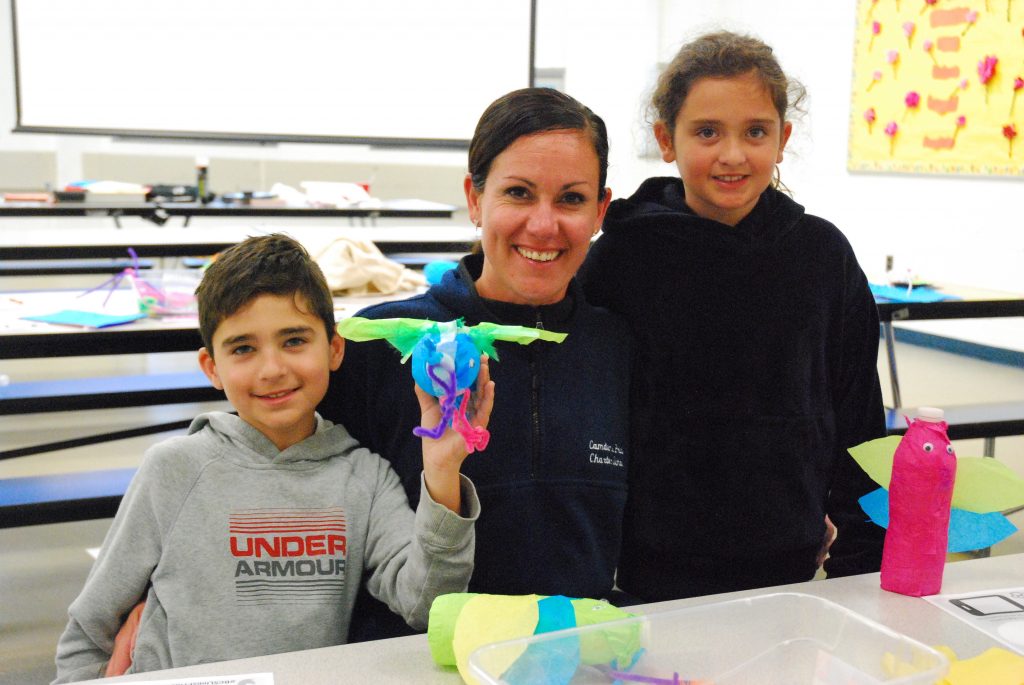

As the world moves forward, so does technology, making the world more and more complex and advanced. In such an ever-changing world, what is taught in schools, and how it’s taught, continues to be ever-changing as well.
Berlin Community School celebrated BCS Lions Pride Night, the first of its kind at BCS, Wednesday, May 1 to celebrate 21st century learning. Families and guests were invited to BCS to explore and discover through a variety of hands-on and digital activities that support the district’s future ready initiatives.
Beth Steinen, director of instruction, achievement and student activities with BCS, helped put together the event and believes that the several activities that were on display throughout the night highlight what BCS is all about.
“At Berlin Community School, we strive to offer opportunities to our students to experience voice and choice across the STEAM spectrum,” Steinen said. “All of our students participate in STEAM activities throughout the year, such as engineering challenges, coding, art and more, and community events like this are a wonderful opportunity to allow families to participate in all of the fun things their children do in school.”
During the two-hour event, students and guests had the opportunity to experience four activities.
Middle school students in the gifted and talented program presented their own five- to seven-minute TED talks, thanks to help from pre-engineering teacher Mike Galeone, who also teaches the gifted and talented program.
Finding inspiration from Google, which in the past had given its employees 20 percent of the workweek to work own personal projects that would help the company, BCS decided the replicate this process. A total of 13 students at BCS presented on a wide range of topics, from autism, the immigration process, the effects of bullying on mental health and more.
“They could pick any topic they wanted as long as they explained why they were passionate about it and how it would help the community,” Galeone said.
The students conducted their own research to understand topics of their interest, while also reaching out to an expert or someone with personal experience on their given topic, leading students to contact medical professionals, university professors and more.
Additionally, the students had to find a medium by which to make their research accessible to the public, such as social media or YouTube.
Galeone said the beauty of the projects was that the students picked something they’re personally interested in, allowing them to research information out of pure interest and not just because of an assignment.
“I guide them, but when they come in they get right to work, they’re just off doing their own research,” said Galeone. “They’re pretty self-motivated.”
Also on display during the night was the eighth-grade art exhibit in Luke Weichmann’s classroom, showing the work of nearly 30 students, ranging from drawing, printmakers, ceramics, self-portraits and more.
Work on display was from students who chose art as an elective for their final year at BCS, making it a special way to commemorate a school year of hard work. While in recent years some school districts are cutting art classes, he is thankful that he is able to continue teaching the importance of not only art, but also creativity as well.
“Maybe none of these kids become quote-on-quote artists, but I think it’s a big deal,” said Weichmann. “I try to tell them that I’m not really an art teacher, I’m a creativity teacher. If you’re going to be an astronaut, you’re going to need to be creative. If you’re going to be an engineer, you’re going to need to be creative – you’re going to need to think of things people haven’t thought of.”
“That’s what art is really about to me, it’s about them finding their own unique solutions to different challenges, whether it’s English, math or whatever it might be,” said Weichmann.
Students were also able to practice coding during the “Hour of Code” at BCS during the night with Grace Nasto.
“They’re practicing block coding, which was originally started to inspire students to study the field of computer programming … so it’s getting them to think like a programmer,” said Nasto. “They can start at a very young age thinking like a programmer. The field of computer science has the biggest job opportunity, but the least amount of people entering it all across the globe.”
Nasto help guide students through multiple on-screen scenarios, as they practiced with free versions of programs revolving around popular games or movies such as “Minecraft,” “Star Wars,” “Flappy Bird” and more.
Nasto also said that another drive around the hour of code is to get more young girls and minorities involved in computer programming, to get their input and way of thinking involved in the language of computer programming.
“If you start getting them involved at a younger level, the hope is that they stay involved all the way through high school,” said Nasto.
Additionally, STEAM teacher Michael Ford led a program on making models of fireflies using a plastic water bottle and other household materials, connecting the school’s STEAM initiatives and Green Team work in recent months.









